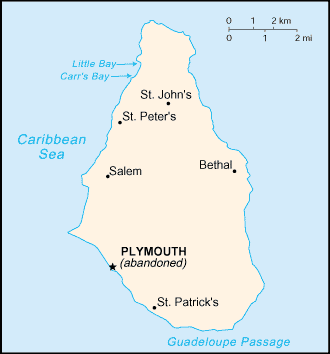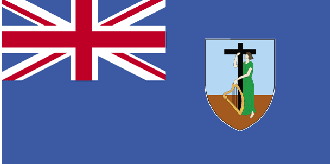
|
Montserrat
Background:
Much of this island has been devastated and two-thirds of the population has
fled abroad due to the eruption of the Soufriere Hills Volcano that began on 18
July 1995.
Location:
Location: Caribbean, island in the Caribbean Sea, southeast of Puerto Rico.
Area: total: 102 sq km.
Area - comparative: About 0.6 times the size of Washington, DC.
Coastline: 40 km.
Climate and Terrain:
Climate: Tropical; little daily or seasonal temperature variation.
Terrain: Volcanic island, mostly mountainous, with small coastal lowland.
Natural hazards: Severe hurricanes (June to November); volcanic eruptions
(Soufriere Hills volcano has erupted continuously since 1996).
Geography - note: The island is entirely volcanic in origin and contains seven
active volcanoes.
People:
Population: 8,995; note: an estimated 8,000 refugees left the island following
the resumption of volcanic activity in July 1995; some have returned.
Ethnic groups: Black, white.
Religions: Anglican, Methodist, Roman Catholic, Pentecostal, Seventh-Day
Adventist, other Christian denominations.
Languages: English.
Government:
Dependency status: Overseas territory of the UK.
Capital: Plymouth (abandoned in 1997 due to volcanic activity; interim
government buildings have been built at Brades Estate, in the Carr's Bay/Little
Bay vicinity at the northwest end of Montserrat).
Economy overview:
Severe volcanic activity, which began in July 1995, has put a damper on this
small, open economy. A catastrophic eruption in June 1997 closed the airports
and seaports, causing further economic and social dislocation. Two-thirds of
the 12,000 inhabitants fled the island. Some began to return in 1998, but lack
of housing limited the number. The agriculture sector continued to be affected
by the lack of suitable land for farming and the destruction of crops.
Prospects for the economy depend largely on developments in relation to the
volcano and on public sector construction activity. The UK has launched a
three-year $122.8 million aid program to help reconstruct the economy. Half of
the island is expected to remain uninhabitable for another decade.
Statistics:
Telephones - main lines in use: 4,000.
Telephones - mobile cellular: 70.
Radio broadcast stations: AM 1, FM 2.
Radios: 7,000.
Television broadcast stations: 1.
Televisions: 3,000.
Railways: 0 km
Highways: Total: 227 km; note: volcanic eruptions beginning in 1995 destroyed
most of the road system (2003).
Airports: None; only airport was destroyed by volcanic activity; a helicopter
service to Antigua is used.
Return to Visiting Locations
|

